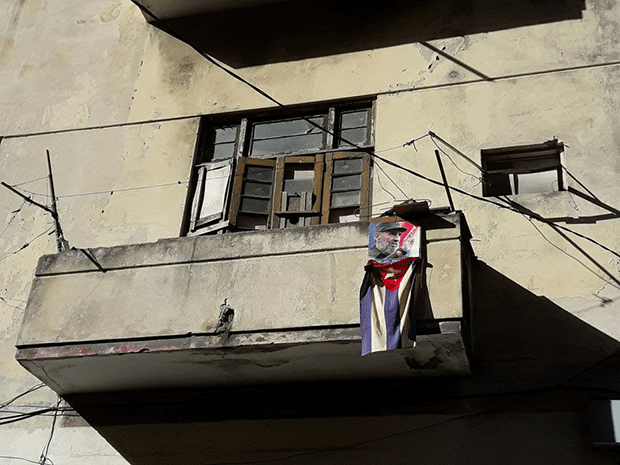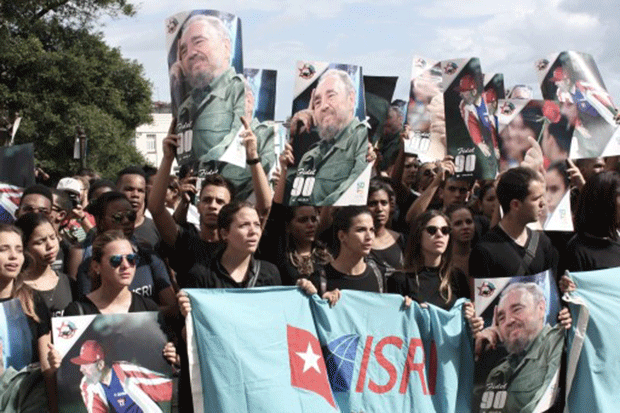Snapshots of the first day in Havana since 1959 without Fidel, from Cuba’s El Estornudo:
A pink 1953 Chevrolet slides along San Lazaro Street in central Havana. Inside, the driver and five passengers. On the front seat an adult couple, both in their fifties, embracing. In the back, a woman with her daughter; the mother is 65 and the daughter, her head resting on the shoulder of her mother, is 32. On the stereo they are playing Silvio Rodriguez. No one speaks. It is the 26th of November 2016 and these are the first hours of the Cuban revolution without Fidel.

A taxi driver, 54, has come to work in spite of his unstable blood pressure. At home, when his wife awoke him with a cup of morning coffee mixed with the news of the death of Fidel Castro, she didn’t expect it to set off his hypertension. Antonio says: “People can agree or disagree with him and his ideas, but Cuba is Fidel. He put us on the map.”
The day before, Antonio went to bed at around 10 at night. A couple of hours later, Cuban TV broadcast a message from Raul Castro. The trembling voice and nervous hands of the president of Cuba informed the world of the death of his brother, the historical leader of post-1959 Cuba.
In the early hours of the morning, the streets remained empty, silent. Many people learned the news at dawn. The only thing to be heard was the household murmur of the tvs and radio stations broadcasting the special news report.
Near the polling station where Fidel used to vote, in Vedado, just steps from one of his old temporary residences, a few balconies display the Cuban flag, fluttering in the wind. The guard-posts in this downtown military garrison are still manned by Interior ministry sentinels. At 9 in the morning, they make the customary change of watch. Here, everything goes on as usual.

Before midday, downtown Havana and Old Havana are more crowded than Vedado. There are more people are out walking, more people going about their daily business. An old man of 78, an architect, on his balcony overlooking Amistad Street, above the Palermo Bar, has hung an old poster with the face of Fidel and a tiny Cuban flag. Below, all the foreign tourists take pictures of the crumbling building.
“Maybe we didn’t think this day would ever come, but here it is,” says the retiree, Heberto Suarez. “Lots of people were waiting for this to happen because they thought this would change things, but these people don’t know that nobody changes Cuba, that the only person who could do anything at all with it was Fidel.”
A couple of blocks from Heberto’s house, across San Rafael Boulevard, five police patrol cars are parked in a line. Heberto says: “They’ve been here since dawn, the fear is that there are some dissidents who live in that building; they’re definitely there to make sure they don’t come out on the street to raise a ruckus and shout nonsense.”
Right in front of where San Rafael Boulevard begins is Havana’s Central Park. In the park’s inevitable sports club, they’re not talking, for once, about the national baseball finals or the US NBA scores. They’re talking about Fidel.

Sitting on the concrete benches, one man says to another: “I had to get out of the house because I couldn’t stand the antena (illegally watched foreign television broadcast) anymore, I just can’t figure out how over in Miami they can celebrate somebody dying.” Hearing them in passing, a woman puts in that “he who celebrates death will have his punishment.” And she continues on her way.
A man of 35 who doesn’t want to give his name joins the conversation. He’s black, wearing a baseball cap with the brim backwards, jeans and a collarless pullover. He interjects, in an eastern accent: “My condolences to any friends of Fidel Castro; I don’t like communism and didn’t like him but you had to admire the guy. I was in prison for 16 years and I don’t hold it against him, that’s the craziest part.”
With this interjection, the debate grows more heated. An old man who has kept his silence so far says: “When Hitler, when Stalin died, when Lenin died, all of their rivals celebrated and that’s why in Miami they’re beating the drums now.”
The black man in the baseball cap shoots back: “just cockroaches, cowards, they couldn’t deal with him while he was alive. Look, I didn’t like Fidel at all but nobody can deny his accomplishments, the guy took on Batista with wooden shotguns and stone pistols and he seized the power.”

At the University of Havana, students and teachers gather to pay tribute to Fidel Castro. On the Escalenata stairs, in front of the Alma Mater statue, students chant slogans like: “You can hear it, you can feel it, Fidel is among us.” And sing over and over the national hymn. There are tears on the faces, throats are closed.
Outside the Law School where Fidel himself studied in his university days, there is a kind of mini photographic exposition memorializing Fidel’s student years.
A leaden evening falls on the Playa neighborhood of Havana. There is a frightening quiet to the streets. A cold wind. A single drum beat. On Eleventh Street, from the house where the drum sounded, a man dressed all in white comes out, a green and yellow cap on his head. He looks up at the sky and says in a low voice: “Iburu Iboya Fidel” [a Santeria invocation], he crosses himself and goes out walking.
Abraham Jiménez Enoa Translated from Spanish by International Boulevard
29 Nov 2016




































